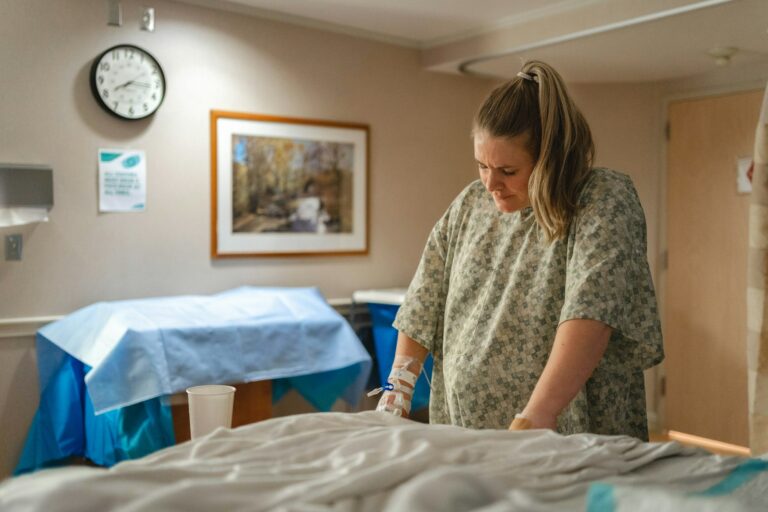The moment you cross the threshold from hospital to home with a newborn marks a major shift—one often danced with a blend of anticipation and uncertainty. Preparing for hospital discharge after childbirth is not simply a matter of packing bags or signing documents; it’s a pivotal handover of care, where expert hands transition daily responsibilities to yours. Many parents quietly wonder: Will I notice complications if they arise? Is my baby feeding well enough? What about my own recovery—how can I keep track? Sleep deprivation, anxiety about feeding, paperwork, and the practicalities of day-to-day adjustment can suddenly press in all at once. The solution? Knowledge, structure, and thoughtful support. Here, we explore every layer of this transition, from tailored medical guidance and baby care routines, to emotional reassurance, family support, and the practical intricacies that so often go unspoken in the rush home.
Early Preparation: The Power of Anticipation
No two births, or families, are identical. Still, preparing for hospital discharge after childbirth offers universal benefits: a head start on postnatal confidence, readiness to identify danger signs in both mother and baby, and reduced stress for the road ahead. Starting before the day of discharge, hospital teams provide comprehensive postpartum care education—covering not only baby feeding cues and home hygiene, but also maternal health, including specifics on wound healing after either a vaginal delivery or cesarean section. Why this timeline? Anticipating needs gives space to absorb detailed checklists, learn new skills like car seat safety, and ensure home support is lined up, especially important as many families now return home within 48 to 72 hours.
Hospital Stay Duration: What Determines When You Go Home?
Timing is not a fixed number—it’s a dynamic interplay. Generally, after an uncomplicated vaginal birth, families are invited to go home after 24–48 hours; following a cesarean, average stays range from 36 to 48 hours, extending as necessary for medical oversight. Key factors?
- Type of delivery (vaginal, assisted, or cesarean)
- Maternal and neonatal health, including resolution of immediate recovery issues like persistent bleeding or inadequate pain control
- Completion of newborn screening tests (such as metabolic and hearing tests)
- Family resources—including social support, safe housing, and transportation.
Longer stays may be required for complications, the birth of multiples, or neonatal intensive care needs. Social and logistical concerns—access to follow-up care, insurance coverage, or transportation home—sometimes delay discharge, yet all are addressed as part of the official plan.
Comprehensive Assessment: Ensuring Safe Discharge
What does “ready to go home” actually mean? Before green-lighting a discharge, clinicians systematically review:
- Mother’s recovery: Monitoring vital signs, checking for infection, wound healing (incision or perineal), mobility, urination, and emotional stability
- Baby’s stability: Physical exam, weight check, effective feeding, temperature regulation, and newborn screening results
- Skills demonstration: Can parents demonstrate safe feeding (breast or bottle), bathing, diapering, and recognize signs of distress?
- Emotional and social considerations: Has the parent or primary caregiver received guidance on postpartum depression, and is in-home support assured?
Validation is sought through direct demonstration, teach-back questioning (“Can you show how you’d hold the baby for feeding?”), and provision of written resources reinforcing verbal education. Both parties must leave with clarity on when to seek urgent medical help, for themselves and their child.
Support Networks and Home Readiness
Arriving home should never mean isolation. Safety and comfort rely deeply on social context: family support systems, established links to health professionals, and practical arrangements for help with older siblings, meals, or household tasks. Some households have a robust safety net; others lack immediate assistance—both scenarios require tailored planning. Medical teams frequently help families identify community resources, address language barriers, and clarify financial or transportation needs. All these elements are central in preparing for hospital discharge after childbirth, laying foundations for a more secure start.
Paperwork, Documentation, and Final Health Checks
No small detail is left untouched. From discharge documents (including summaries of treatments, medications, and required follow-up appointments) to birth certificate or health insurance paperwork, the administrative load can feel overwhelming. Both mother and baby receive thorough last-minute vital signs assessments, wound checks, and feeding observations. Only when medical and procedural checklists are satisfied is discharge officially completed.
What To Pack: The Checklist for Discharge Success
Parents are often surprised by how practicalities shape their hospital experience. A thoughtfully packed bag does more for preparing for hospital discharge after childbirth than most realize.
- For mothers: ID, insurance, essential medications, comfortable clothing (nursing bras, loose pants, oversized underwear), postpartum pads, toiletries, snack bars, water bottle, peri bottle, and pain relief items.
- For the baby: Washed outfits, socks, hats, blanket, rear-facing infant car seat (installed according to up-to-date safety guidelines), preferred diapers/wipes, nail clippers, and feeding supplies (nursing pillow or bottles as needed).
It’s all about anticipating needs and smoothing the way home, when new routines will dominate your days and sleep may, temporarily, become a rare luxury.
Home Organization: Creating a Safe Environment
Once at home, physical arrangement is where preparing for hospital discharge after childbirth meets daily reality. The baby’s safe sleep environment must feature a firm mattress, no loose bedding, and no toys or pillows (to reduce the risk of Sudden Infant Death Syndrome, SIDS). Stock hygienic supplies—diapers, wipes, feeding gear, sanitized bottles or breast pump, pads and basic pain medication for ongoing recovery. Prepare nutritious meals in advance (if possible) and enlist help with chores: in the early days, your priority should be rest, recovery, and close attention to your new child.
Emotional Wellbeing: Building Parental Confidence
The emotional turbulence of postpartum life deserves as much attention as the physical. Emotional highs and lows, sleep deprivation, and anxieties about competence or connection are normal—and often transient—but warrant awareness.
- Open conversations with partners, sharing daily needs and offering mutual reassurance
- Involving family and friends, delegating where possible to create breathing room for rest
- Recognizing warning signs: intense mood swings, lasting sadness, or difficulty bonding with your newborn may signal postpartum depression—and timely external support can make recovery smoother.
Adapt the family dynamic with patience; adjust routines collaboratively, allow for flexibility, and remember that everyone is learning anew. Communication and kindness strengthen parental resilience.
Pain Management and Physical Recovery
Pain and fatigue are expected companions after birth. Post-vaginal delivery soreness can be eased using cold packs, witch hazel pads, and gentle hygiene with a peri bottle. Cesarean recovery requires diligent wound care, avoidance of heavy lifting, and proper pain management, including, if prescribed, stool softeners or wound creams.
- Monitor for warning signs: fever, excessive bleeding, or severe/incision pain
- Listen to your body, ask for help, and attend all medical follow-ups
Nutrition, hydration, and rest remain the best allies for tissue healing and hormonal balance. Recovery rates vary—be patient with yourself and stay alert for complications.
Baby Care: Feeding, Hygiene, and Safe Sleep
Newborn care sharpens focus on the basics, yet each step matters. Feed infants on demand—typically every 2–3 hours initially—using either breastmilk or formula, according to personal choice and medical advice. Always place the newborn on their back for sleep (room-sharing, but not bed-sharing, is safest). Cleanse the umbilical cord with plain water, allow it to dry and fall off naturally, and fold diapers below it to prevent irritation.
- Monitor for illness: fever, difficulty feeding, persistent jaundice, or excessive crying are all reasons for prompt medical consultation.
- Keep a feeding and diaper log—helpful both for parents and healthcare providers tracking health indicators.
Addressing Barriers and Overcoming Early Challenges
Many parents struggle with fatigue, anxious thoughts, feeding complications, or the feeling of information overload. Prioritize rest above unimportant chores, accept support, and set manageable routines. If practical challenges become overwhelming, community resources—such as visiting nurses, new parent networks, or postpartum doulas—can make an enormous difference.
Gentle Routines and Ongoing Support
Flexible routines eventually form, guided by your child’s cues and your family’s rhythm. Keep lines of communication open with healthcare professionals: every question is valid, and reassurance in the early weeks often makes a tangible difference. Adjust your caregiving approach as your confidence grows—remember, your expertise as a parent develops with each day.
Key Takeaways
- Preparing for hospital discharge after childbirth is a structured, supportive process—emphasizing advanced planning, sound medical guidance, and emotional awareness.
- A safe transition balances expert assessment of maternal and newborn wellbeing, home readiness, comprehensive paperwork, and logistical preparation for follow-up care.
- Strong support networks, open communication, and early understanding of complications are vital protective factors during recovery.
- Each family’s needs and experience differ, yet practical tools—such as checklists, flexible plans, and shared responsibilities—consistently promote smoother adaptation.
- Download the Heloa app for tailored advice and free health questionnaires for your child—helping you receive support, up-to-date medical guidance, and trustworthy resources, all at your fingertips.
Taking time for preparing for hospital discharge after childbirth pays dividends in health, confidence, and calm, laying foundations for a nurturing family start—one informed, supported, and ready to grow together.
Questions Parents Ask
What kind of support can I arrange at home after childbirth?
After returning home, having practical and emotional support can make a real difference. You might consider asking close family or friends to help with daily tasks like preparing meals, looking after older children, or simply offering company and reassurance. Some parents also find help from a postpartum doula or home-visit nurse helpful during the first weeks. Remember, every family is unique—don’t hesitate to express what you need and accept help offered. Feeling supported is an important part of your recovery and adjustment.
What medications or supplies do I need for myself and my baby after discharge?
Before leaving the hospital, clarify with your healthcare team which medications are recommended for your recovery (for example, pain relief, wound care creams, or stool softeners) and if any prescriptions need to be filled. For your baby, basic supplies can include diapers, gentle wipes, clean clothing, feeding equipment, and a safe sleeping space. If your baby requires anything specific—like vitamin drops or prescription creams—it will be detailed on your discharge papers. Having everything ready at home means you can focus on rest and bonding.
How do I know if I should seek medical help after returning home?
It’s natural to feel uncertain about what’s normal, but there are some signals that should prompt you to contact your healthcare provider. For parents, these include persistent heavy bleeding, fever, severe pain (especially around a wound), or signs of infection. For babies, watch for a fever, persistent vomiting, refusal to feed, breathing difficulties, or if they seem unusually sleepy or hard to rouse. If you notice anything that worries you, trust your instincts and reach out for support. There’s no such thing as a silly question when it comes to your health or your baby’s wellbeing.









